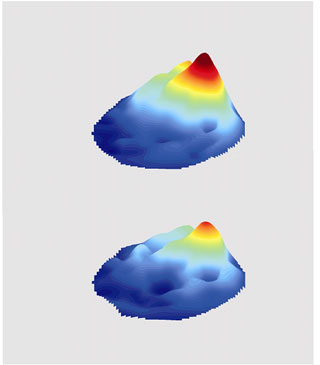
Human primary visual response to the same motion stimulus was varied with the perception but not with the stimulus.
The figure shows the three dimensional magnetic field gradient maps of the responses for the two perceptions (viewing from the left anterior). Top: horizontal motion perception; bottom: vertical motion perception to the same bistable apparent motion stimulus.
Ogawa T and Komatsu H
Condition-dependent and condition-independent target selection in the macaque posterior parietal cortex.
J Neurophysiology, 101:721-736, 2009.
Although it has been shown that an alternative dominant percept induced by an ambiguous visual scene has neural correlates in various cortical areas, it is not known how such a dominant percept is maintained until it switches to another. We measured the primary visual response to the two-frame bistable apparent motion stimulus (stroboscopic alternative motion) when observers continuously perceived one motion and compared this with the response for another motion using magnetoencephalography. We observed a response component at around 160 ms after the frame change, the amplitude of which depended on the perceived motion. In contrast, brain responses to less ambiguous and physically unambiguous motions in both the horizontal and vertical directions did not evoke such a component. The differential response evoked by the bistable apparent motion is therefore distinct from directionally-selective visual responses. The results indicate the existence of neural activity related to establish and maintain one dominant percept, the magnitude of which is related to the ambiguity of the stimulus. This is in the line with the currently proposed idea that dominant percept is established in the distributed cortical areas including the early visual areas. Further, the existence of the neural activity induced only by the ambiguous image suggests that the competitive neural activities for the two possible percepts exist even when one dominant image is continuously perceived.